#makasan indonesia
Text
Close Encounters
The Home Stretch
Hello family and friends, Helen here, taking back control (eeep, it’s gone all political…), after the recent fantastic takeover by my sister Jo.
Sam and I parted company with Jo when she headed to the international terminal to take her flight back to the UK. With Sam’s ears still playing up, we finally gave up on diving together. So we sent our dive gear back with Jo and decided to try something different for our final ten days in Indonesia.
Sam and I flew north-west, landing in Medan in North Sumatra, the most populous city in Indonesia outside the island of Java. Having been about as far east as you can go in Indonesia just ten days ago when exploring Raja Ampat, we were now pretty much as far west as possible. We spent a couple of days in Medan planning the remainder of our Indonesian trip and wandering around. The city was bedecked with beautiful decorations in honour of the Lunar New Year, with whole streets hung with red lanterns and individual shops erecting lavish displays. On our second night in the hotel, we received a phonecall asking us to answer our room door because the staff “wanted to give us fruit”, where upon doing so two members of staff shyly handed us a red note wishing us a Happy Chinese New Year and two oranges. Adorable!
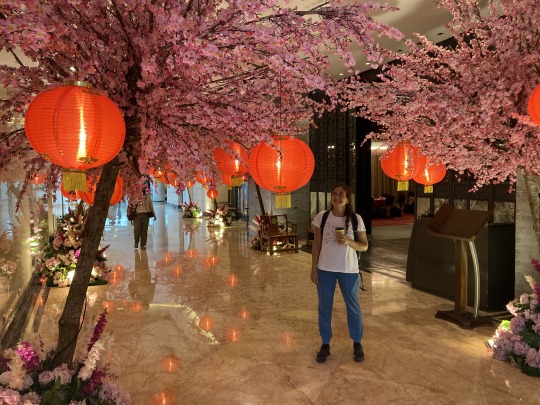
Photo Above: one of the beautiful displays in honour of the Lunar New Year
Given our love of food, we ended up doing a bit of a gastro-tour—Medan is the first place we’d been in Indonesia with a large Chinese-Indonesian (and therefore often Buddhist) population, so we found that it was incredible for vegetarians and vegans. We saw next to no foreigners, so these food spots were always aimed at locals—in fact, the Chinese-Indonesian owner of one of the vegan restaurants told us the story of visiting Ubud (the alternative yoga and arts town in Bali that we visited in November, which also had a strong vegan food scene) and how, upon walking into a vegan restaurant, he looked around in complete astonishment at the clientele and exclaimed, “where are the Chinese?!”. Given that there were so few foreigners, we were somewhat of a novelty. Case in point, when we stopped by a roadside vegetarian Makasan Padang place (Makasan Padang being a typical Sumatran cuisine, and one of Sam’s favourites from our trip), the staff requested a team photo with us.
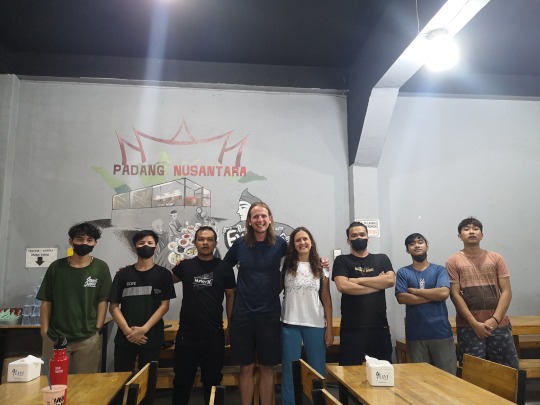
Photo Above: veggie Makasan Padang team photo!
Though Sam’s back was slowly improving, it was still causing him a fair amount of pain, so we decided to be fancy people and for the princely sum of about £15 ($19), we bought a day pass to the Marriott hotel spa to have a lovely romantic day relaxing together. We took the lifts all the way up to the spa on the seventeenth floor, our heads full of visions of our romantic day spent chatting away together in the sauna and steam room. What we didn’t account for, however, was the fact that in a Muslim-majority place, the sauna, steam room, and jacuzzi were very definitely gender-divided. So instead, during the morning when there were no men using the facilities, Sam convinced me to cheekily sneak into the men’s facilities. Later, when it got busier, we did our hardcore relaxing separately and periodically met up to swim lengths of the outdoor infinity swimming pool (complete with incredible views across the city) and giggle at the turn of events.

Photo Above: the luxurious infinity swimming pool with a view across Medan
After a couple of days eating and relaxing in Medan, we made the three-hour journey west to the rainforest village of Bukit Lawang, famous as the gateway into the jungle that is home to the Sumatran Orangutans. As the city morphed into tropical countryside, we began passing palm oil plantations, which stretched for miles along the rest of our journey. When we reached the village of Bukit Lawang itself, we were welcomed by someone from our accommodation. He hoisted our large bag onto his shoulders and led us down a small alleyway, then along a dirt track besides a river lined with rickety wooden buildings and across a narrow pedestrian suspension bridge spanning the river. On the other side, we began scaling 270 stairs, climbing high until we reached On the Rocks, our home for the next while. The lodge was nestled right next to the border of the Gunung Leuser National Park, so we picked a small, wooden cabin built into the steep side of the hill, complete with huge balcony overlooking the rainforest and a vast glassy window in the bathroom meaning we had a loo with a spectacular view. That evening, we fell asleep to a vast soundscape of rushing river, buzzing cicadas, and chattering monkeys. When we stepped onto our balcony the next morning, a troupe of Thomas’ leaf monkeys (an endemic species of primate with distinctive black and white facial markings) were climbing the trees a few metres from us and play-squabbling amongst themselves.


Photos Above: the palm oil plantations lining the road; serious porter skills
We spent a couple of days relaxing in the lodge, going for a wander around the village (mostly so that I could gleefully walk back and forth on as many of the rickety bridges as possible for fun), soaking up the stunning views, and relaxing into the lushness of the rainforest sounds, smells, and foliage.
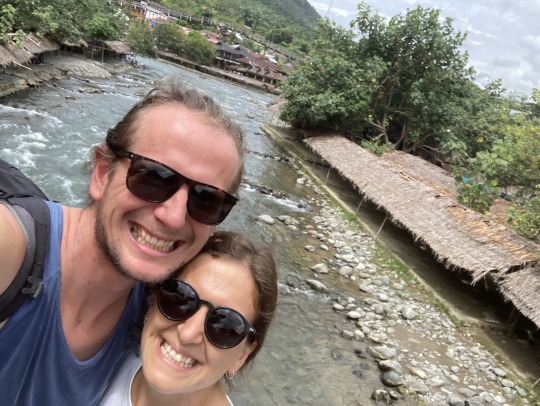
Photo Above: exploring the village
Into the Wild
On our third day there, we each packed a small rucksack and met our trekking group for the next few days up at the lodge’s restaurant. As I’m such a keen bean about all fauna, I had done my ape research beforehand. The word orangutan is, in fact, from the Indonesian, meaning “forest person”. There are three species of orangutan in the world, the Sumatran Orangutans we hoped to see being found only in Sumatra, as their name suggests. They are critically endangered, with only an estimated 14,600 remaining in the wild.
Just before we set out, a shout went up—a short way across the valley, a female orangutan and her adolescent baby were making their slow, swinging way through the trees, the mother sometimes acting as a bridge between two trees for her child to climb across. I was completely entranced by their movement, especially their seemingly outsized arms, which were far longer than their legs—orangutans can’t jump, so they always move through the trees limb to limb. As everyone joked, no need to go on the trek now!
We set off into the jungle. Our On the Rocks team was made up of an extended group—there was Ulf and Zilke, a German couple travelling with their children, Lulu (12) and Alvin (8), who were doing a shorter route than us each day, so had their own two guides, while our immediate group included Magda and Max, a couple from Germany, led by Ling and supported by Bincar. Later it would become apparent why having two guides per group was so important.
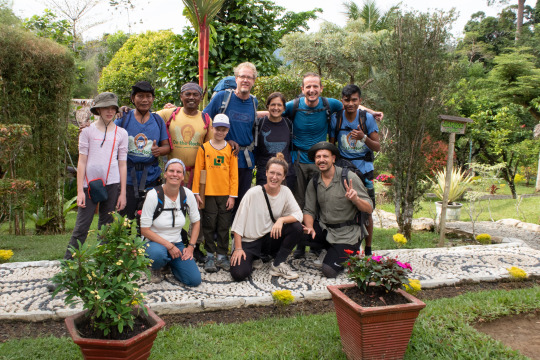
Photo Above: our extended trekking group
The trekking started gently, as we followed a trail through the jungle and Ling pointed out interesting things to us—first, the solidified gum from a gum tree, then the pungent smell of orangutans, and then a short while later, some more Thomas’ leaf monkeys who casually came down to the forest floor to check us out. We also came upon the orangutan mother and baby we had seen from the lodge and hung out below them for a while. As we walked, Ling would scan his eyes through the canopy and I could practically see his ears stood on end, so tuned in was he to his surroundings. He would periodically make orangutan noises, the sound of the female sounding like someone doing a loud kiss into the palm of their hand, while the male noise was much more like a deep gruff cough. It turned out that Ling was super experienced, having been guiding in this jungle since 1999, and it was quickly evident how much he loved the forest and how completely at home he was in it.

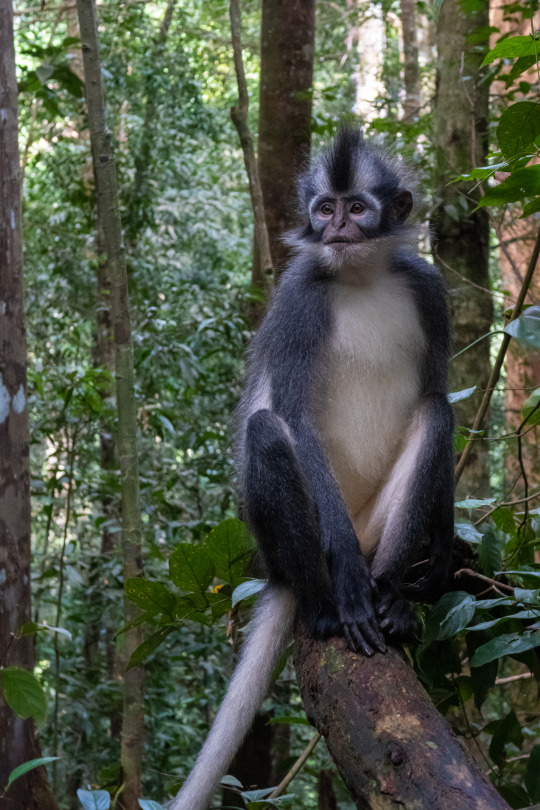
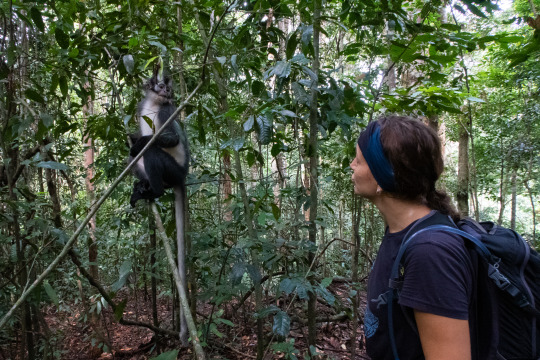
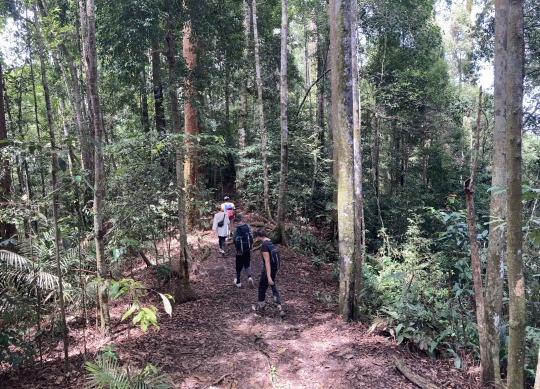
Photos Above: me gazing up at a huge gum tree; a Thomas' Leaf Monkey; making friends; walking the rainforest trail
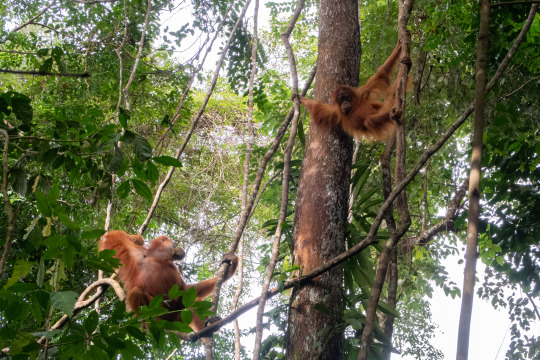

Photos Above; the mother and her baby; the mother orangutan's vast armspan
It was not long before we came across our next orangutans. This was a particularly special experience—it was an adult mother with a tiny, scraggly-looking baby clutching the fur on one side of her torso, so newly born that it’s umbilicus still hung from it, swinging in the air as the mother moved. Our guides figured that the baby was merely a day or two old, and we watched as the mother kept gently touching her fingers to her vagina and licking them because she was still bleeding from the birth. While her own fine-haired fur was a vivid russet colour, her baby looked like a pale, wrinkly little Gollum. She seemed completely unfussed by the humans peering up at her and in fact slowly swung her way towards and above us so that she passed within a few metres. I couldn’t stop staring at her, especially her face, which seemed so expressive that it was hard not to anthropomorphise her.
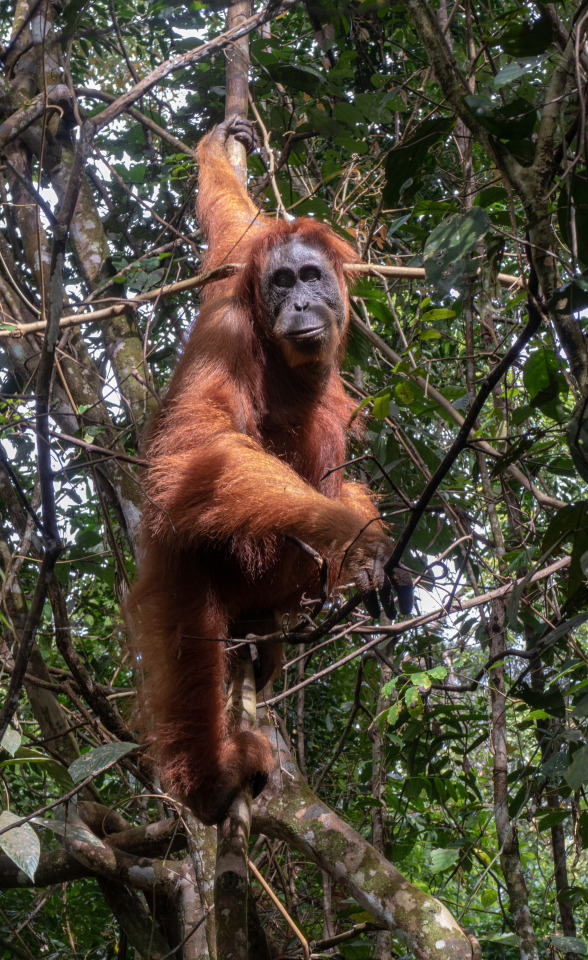

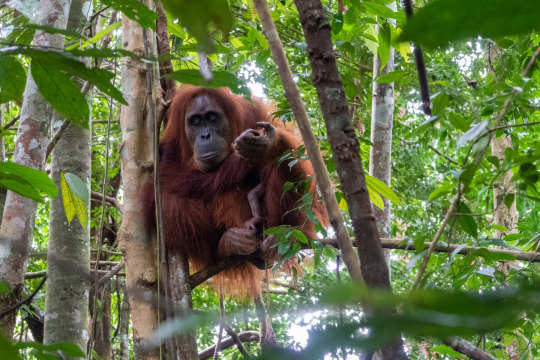

Photos Above: mama orangutan; the mother on the move, her baby clutching her side as she holds the umbilicus; chilling in the tree; inspecting the umbilicus
The second half of the trekking that day became a lot more difficult—Ling and Bincar kept up the calls of “hati hati!” (“take care!”). The terrain was at first steeply uphill and then extremely downhill, so much so that often instead of walking, we had to climb, using lianas or thick tree roots protruding from the soil as handles to help us down. By the time we reached our camp for the evening and rejoined the German family, we all felt ready for a dip in the cool water of the nearby stream. Afterwards we sat around altogether chatting, while the guides and kids carved orangutan faces into small, reddish clay pebbles from the river to create a jungle necklace. Ling handed his first carving over to me as a gift.
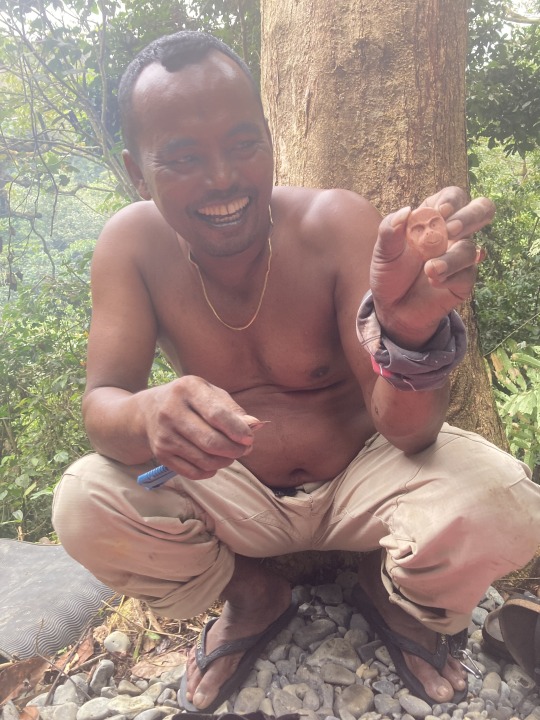
Photo Above: Ling carves me an orangutan pendant from a pebble
Our camp was made up of one roofed hut where two cooks had lit several fires to cook our dinner, plus two other roofed structures under which we would sleep for the night. With the leakproof roof, spongy mattress mats, and a large mosquito net hung over myself and Sam, it felt pretty luxurious. As the rain started that evening, we all crowded into one of the huts to be served up a feast of vegetable curry, spiced tofu and tempe, rice, and cooked vegetables. Sam and I had a great time watching the children tell raucous jokes in German—though we mostly couldn’t understand, there was plenty to appreciate in the sheer joyful giggles from the rest of the group. Though I may struggle to sleep in cities with the sound of traffic passing by, it turns out that thunderous rain on a tarp-and-thatch roof does just the trick.

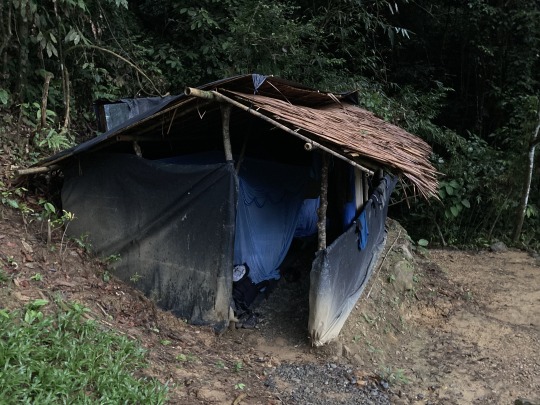
Photos Above: the cooking hut with the rainforest view behind; our bedroom for the night
Face to Face
The next day, we had a nice slow morning. Everyone sat outside, carving more orangutan pendants from pebbles, drinking tea and coffee poured from coconut husk teapots into coconut husk cups, and watching a group of Long-Tailed Macaques low in the trees around us, clearly waiting for us to leave camp before they would trawl the place to check for any leftover goodies. I managed to acquire a leech between my toes, and when I calmly pulled it off and pressed some tissue to the mini wound it had left, I caught several of the guides casting eyes at each other before one asked, was I not afraid? Turned out that they had come to expect a screeching reaction from guests.
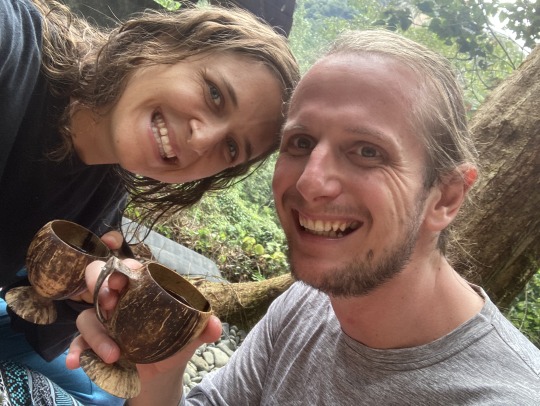
Photo Above: a genteel rainforest breakfast
I may be nonplussed by bloodsucking leeches but when we set off trekking, I found I was extremely stiff. Because of Sam’s sore back, I was carrying almost all of our water for the day and so climbing up the steep hill, I felt a bit like a tortoise trying not to swing backwards onto its heavy shell. But after an hour or so and a couple of steep slopes up and down, I had settled back into the rhythm of things. At the top of one hill, we dumped our bags amid the tree roots and paused while Ling wandered a short way away making his usual orangutan noises to see if there was anything in the vicinity. Suddenly we heard him shout “Run, run, take your bags, run!”. We couldn’t tell if he was yelling in excitement or fear nor if he wanted us to run towards him or away. Then he came dashing up to us, shouting that a male orangutan was coming. Though humans rarely experience issues with female adults, male orangutans can be aggressive, especially when patrolling their territory, and to have a large one down on the ground was unusual. We dashed up the opposite hill, just as the big male came sloping into the clearing. Rather than following us, he paused to sit at the base of a tree, simply peering at us, perhaps to get a better scope of the situation. Ling stood well in front of us, communicating clearly about how far away we should stand and how to interpret the male’s behaviour but encouraged us to take photos. He was huge, a male named Jarwao who was at least 40 years old Ling later told us, and he was flanged—meaning he had the iconic orangutan face flaps and bulging throat sack. When I had previously researched this phenomenon, I found out that the current best guess as to their purpose is as a kind of megaphone for the calls that males make as part of declaring their territory. I couldn’t contain my excitement—I had been desperate to see a flanged male and here he was, so huge and powerful that I couldn’t tear my eyes away from him. It was barely a minute before he started coming towards us again, his long-muscular arms giving him a formidable presence. Ling held up a huge stick and hit it on the ground—making yourself big and aggressive is an important part of a guide’s role to ensure everyone remains safe. Jarwao didn’t react at all besides simply standing and watching Ling. We all hurriedly walked on, with Ling holding back to create space for us to traverse a steep downhill—he told us that orangutans are extremely fast downhill compared to humans so we trekked all the way down the vast hill before stopping besides a stream for lunch.
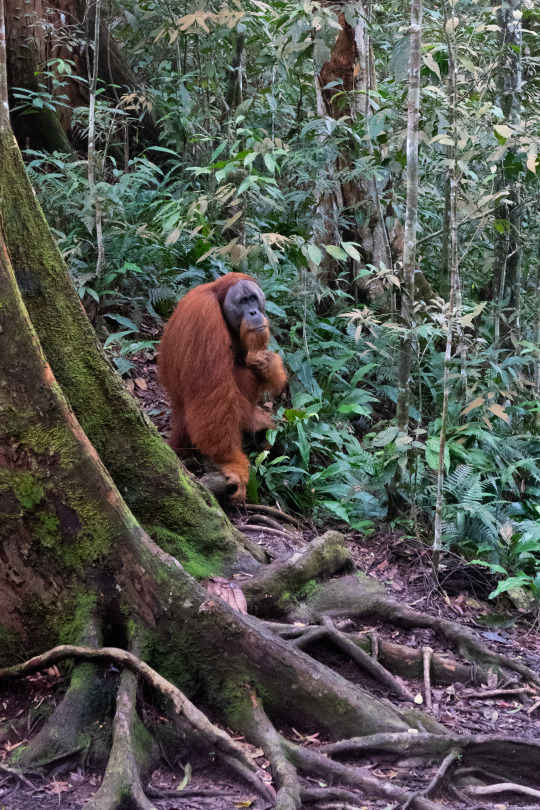

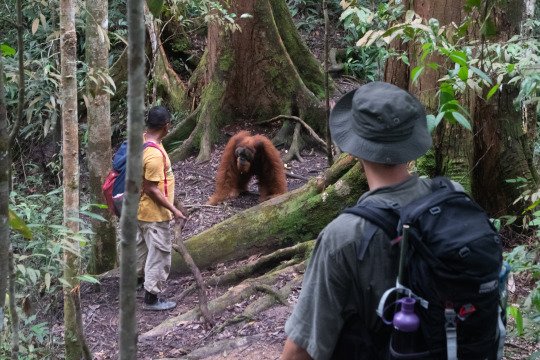

Photos Above: Jarwao appears; a quick snapshot with him; he continues to approach; he pauses and watches us for a while
Bincar and Ling made up little paper pouches of precooked noodles for us and then Ling kept watch looking up the hill. We had been sat about eating and chatting for a good ten minutes when Ling jumped up and told us that the male was coming down the hill. As we grabbed our bags, I saw Max look up and heard him say with shock “He’s there!”. I caught a flash of orange not far from us before everyone fled across the shallow river and began clambering up the steep trail on the other side. I was at the back of the group, with only Ling behind me. As I crossed the stream, I turned momentarily and found myself merely 4 metres from Jarwao, just as he arrived at the opposite bank. We locked eyes and I heard Ling shout a few metres to my side, fear in his voice, for me to RUN. I turned and hared it up the hill. Later, when Sam and I were chatting, we worked out that he had looked back down the hill at this very moment to see Ling throw his rucksack on the ground to distract Jarwao. I scrambled up madly and so only saw one snapshot after that: Ling running downstream between me and Jarwao, Jarwao turning to follow him. He yelled some instructions at Bincar—I presume he told him to lead us up the hill and away.
We all raced upwards not saying a word. Bincar swapped places with me so that he was bringing up the rear until we were right at the top and then he led us silently on. Besides my telling the others what had happened at the bottom, no one said a word. My mind kept turning to Ling flinging himself between me and Jarwao and I desperately hoped he was okay.
Shortly, we came to another group taking a rest and told them what had happened. The guides decided that we should leave one of their guides behind to try find Ling while their other guide and Bincar would escort us to camp. We all began climbing downwards. I was madly concentrating—with my old knee injury, I wasn’t the speediest at downhills, but I knew that injuring myself would present everyone with an even bigger problem. After a while, Ling and the other group’s guide caught up with us. I was glad to see Ling in one place, puffing madly on a cigarette and unscathed besides a bruise on one knee from falling over. He told us to keep hurrying though, so we kept moving until we reached our camp besides a large river at the bottom of the valley. Orangutans don’t come down to the river—it’s too dangerous for them to be out in the open—so the guides knew we’d be safe in the camp.
We dumped our bags, changed into our swimsuits, and slid into the eddies at the edge of the river, where the water wasn’t so strong that it would pull us downstream. After our much-needed chilly dip, we began piecing together the events of the afternoon.
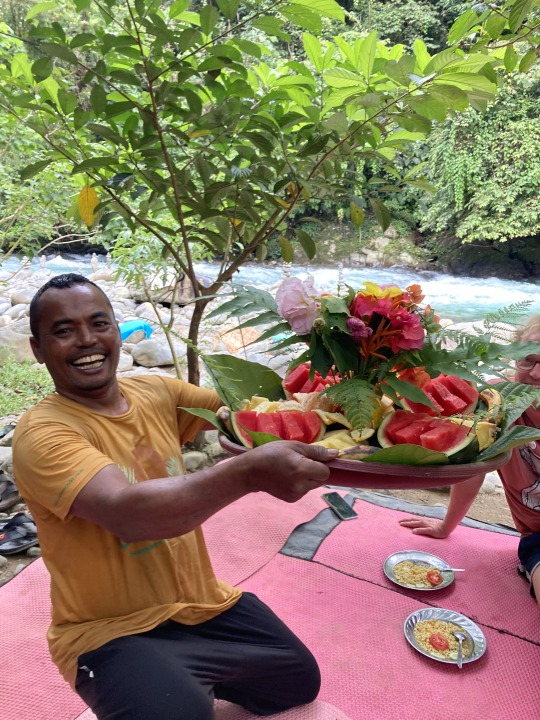
Photo Above: Ling with his beautiful rainforest floral arrangement
Ling told us that though he had had many experiences with males over his more than two decades working in the jungle, it had never been like this. Usually males keep a good 15 metres away, and if they do show any aggression, they quickly fall back when faced with his own tactical “display of aggression”. On top of that, Jarwao usually stayed deep in the jungle and had never been seen this far out, a mere two days walk into the forest. Ling had also never seen a male so angry—he told us that after he used his rucksack as a decoy (he managed to grab it when he ran past), he had run in a loop to keep Jarwao away from the group and twice fell over and nearly had him catch hold of his leg. His best guess as to why Jarwao was so angry was that a group had passed by earlier in the day and potentially fed him—although guides occasionally use fruit to distract a male if in real need, simply feeding orangutans is really discouraged as over time it can change their behaviour and cause more aggression. With all this said, once it became apparent that Ling was okay and that everyone was safe, I quickly felt as though we’d had a real adventure. After all, this was nature, Jarwao was a wild animal, and we were blessed to come out unscathed, in large part due to having such an experienced and courageous guide. When I went to bed that night, I thought of Jarwao standing a few metres across the stream from me and how that vivid moment will stick with me for the rest of my life.
I was up earlier than everyone else the next morning and straight into the river for my morning dip. We had another relaxed morning, with a late breakfast then a short walk upstream to a small waterfall with a deep plunge pool, where I sat under the waterfall itself, letting the stream pummel my shoulders with a deep massage. After lunch, we packed up and watched as the guides and cooks created a special raft for us. They tethered together four black inner tubes, two large in the middle and a smaller one either side. Then they took all our bags and cooking stuff, secured them in several layers of thick plastic bagging, and tied them on top of the inflatable rings. Finally, Sam and I got into one of the large rings in the middle, sitting side by side, while Magda and Max sat in the other large tube. Ling, equipped with a long bamboo pole, sat in the front small ring and one of the cooks, also with a long guiding pole, sat in the back small ring, while Bincar perched on the edge next to Magda. And with that, our team set off down the river. It was extremely fun rafting along for a good 45 minutes, Ling and our cook using the poles to keep us from the banks and guide us through the mini rapids. I spent most of the journey either gazing around at the beauty of the rainforest covering the slopes of the valley on either side of us or giggling at the sprays of cold water that hit us whenever we bumped over rapids.
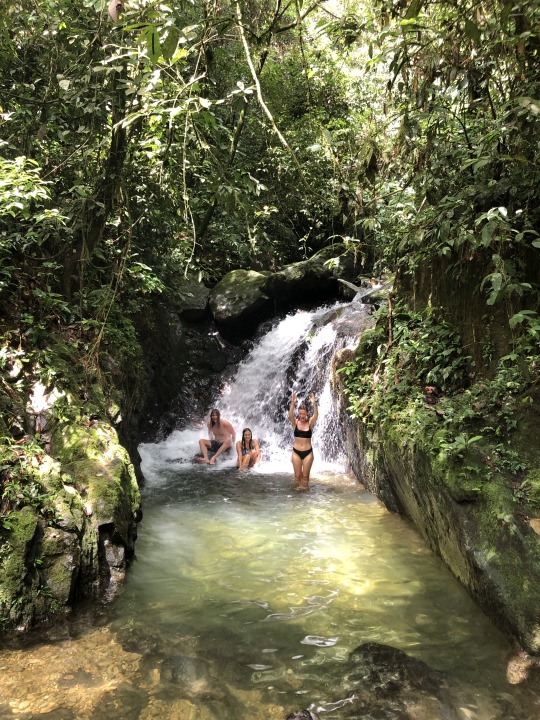
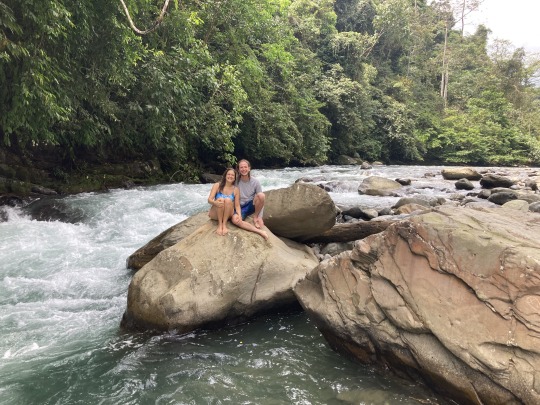
Photos Above: a waterfall massage; beside the river
When we were not too far from arriving back in Bukit Lawang, we pulled up at the riverbank. Our bags were unwrapped and we changed into our hiking gear, looked on by a mother orangutan and her roughly 4-year-old baby sat high in the trees above us. Then Ling led us once again into the forest for our final hike. Safe to say, after three days profusely sweating into our clothes, we all smelt about as strongly as orangutans. We had a fantastic last couple of hours in the rainforest, including seeing another mother, this time with a roughly 1 and a half year old baby, who swung through the branches much more tentatively than the baby we had just seen. As we neared Bukit Lawang, the sounds of the rainforest became punctuated first by a chainsaw, then by music drifting up from the village, and finally, just as we walked back into On the Rocks lodge, the afternoon call to prayer began to sound from the mosque.
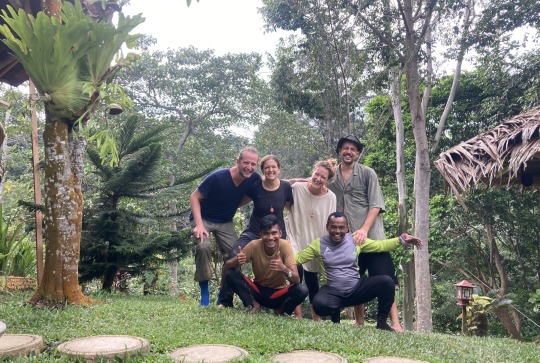
Photo Above: the "after trekking" shot—just as well you can't smell us!
youtube
Video Above: a short compilation of our trek, showing footage of trekking itself, the mother orangutan with her newborn baby, and finally the very few seconds of video we got of the large male, Jarwao
Our Final Indo Hurrah
Safe to say, we all headed straight for a shower. That evening, we ate a vast spread with Max and Magda in the On the Rocks restaurant, unpicking our adventures of the last few days.
The next morning, Sam and I packed up, said our goodbyes to our trekking team, who we felt very bonded with after our shared experience, and headed back to Medan.
Sam and I had just one full day left in Indonesia, so we decided to book into a fancy hotel for a final hurrah. In reality, most of the day was spent running errands and drafting up this update but we did manage a short spa session together, a few final excellent Indo meals, quite a few glasses of complimentary wine, and a whole lot of gazing out at the amazing view of the city from our room on the twenty-third floor.

Photo Above: the spectacular view from our hotel room window
But time has a way of rolling ever onwards, and so we packed our bags, headed to the airport, and boarded a plane for Singapore—for our final few days away, we’re visiting friends who moved out here recently. As the plane took off, we both gazed out of the window. Indonesia had been vast and chaotic and humbling, and above all, oh-so good to us.
2 notes
·
View notes
Photo

Makanan sebagai saluran ekspresi dalam menulis sebenarnya telah mengakar dalam tradisi menulis sejak masa kuno Nusantara. Istilah boga jejaknya mula-mula terlacak dari kata bhoga/bhogi dalam prasasti dan naskah Jawa kuno. Artinya, jauh sebelum era industri kuliner, makanan sudah menjadi ekspresi kenikmatan dan kesenangan… Maka, memerlakukan makanan sekadar sebagai objek kenikmatan tentu berbeda halnya dengan memperlakukan makanan sebagai medium untuk merefleksikan kehidupan melalui tulisan. Dengan memaknai makanan sebagai bagian dari bumbu kehidupan melalui tulisan, kita dapat belajar menghayati kelindan aneka persoalan yang saling berhubungan, mulai dari politik, sosial, budaya, agama, sastra, hingga cinta. Ini bisa dicicipi dari buku 'Sepinggan Indonesia yang sejatinya bukan kisah tentang liyan, melainkan tentang kita sendiri. Ditulis dengan gaya tutur yang renyah, kumpulan tulisan dalam buku ini diselimuti kegembiraan dan kegetiran yang dinarasikan wajar, tidak berlebihan, dan menggunakan makanan sebagai aforismanya. Tidak ada kesan menggurui; malah kita seperti berguru bagaimana menjalani hidup di belantara dunia yang kian pelik dengan masalah ini. Seolah kita diingatkan dengan pesan bijak yang selalu saya ingat: manis jangan lekas ditelan, pahit jangan lekas dibuang… Fadly Rahman (Dosen Program Studi Sejarah Universitas Padjadjaran/Sejarawan Makanan) Yuanita Maya, Sepinggan Indonesia, Mencecap Indonesia Lewat Masakan Tradisionalnya, Yogyakarta, Penerbit Tiga Saudara & Gula Kelapa, Juli 2022, 300 hlm, 145.000 #YuanitaMaya #SepingganIndonesia #Makasan #MasakanIndonesia #Kuliner #PenerbitTigaSaudara (di Jual Buku Sastra-JBS) https://www.instagram.com/p/Cg6Pm2YBjXY/?igshid=NGJjMDIxMWI=
0 notes
Text
Sweet potato korean

Recipe Sweet potato korean
#sweet potato korean#recipe koreanfood#recipe#food#Foodnusantara#makasan indonesia#resep masakan#makanan sehat#potato sweet#recipes potato
0 notes
Quote
Nasi goreng menjadi salah satu makanan yang sangat diminati di daerah Asia, seperti Thailand dan Indonesia. Karena pada kawasan ini orang lebih menyukai makanan yang dimasak dengan bumbu atau rempah dengan rasa yang kuat.
Nasi goreng merupakan makanan asal tiongkok yang populer di Indonesia, bahkan menjadi makanan favorit banyak orang di dunia dan banyak juga restoran yang menyediakan menu nasi goreng. Nasi goreng sangat khas dengan bahan masakan tambahan lain seperti daging, ayam, sayuran, serta tidak lupa menggunakan bumbu-bumbu seperti bawang putih, merica, MSG dan kecap.
Nasi goreng juga sangat bervariasi sehingga ada yang memiliki harga yang murah jika memakannya di pedagang kaki lima hingga harga selangit jika kamu memakannya di restoran-restorsan. Akan tetapi, apa yang kita pandang mengenai nasi goreng yang memiliki gizi yang baik untuk tubuh seperti terdapat karbohidrat, protein nabati maupun hewani serta berbagai macam vitamin dan nutrisi.
Namun, pernyataan tersebut tidaklah sepenuhnya benar. Karena jika kita lihat dari segi kesehatan, makanan populer dikalangan masyarakat Indonesia ini ternyata mempunyai 4 efek buruk nasi goreng bagi kesehatan tubuh. Apalagi jika kita sering mengonsumsi nasi goreng, maka efek bahaya bagi kesehatan akan semakin nyata dan terasa, sebagai berikut:
1. Meningkatkan berat badan
Bagi kaum hawa masalah berat badan yang berlebih merupakan salah satu yang menjadi masalah cukup rumit untuk diatasi. Oleh karena itu, untuk kamu yang sedang menjalankan program diet, mungkin nasi goreng bukanlah pilihan yang baik.
Karena kalor satu porsi nasi goreng ini lumayan besar, dapat dilihat dari segi memasaknya, nasi goreng terbuat dari bahan-bahan seperti nasi putih, minyak atau terkadang sering menggunakan mentega, telur, daging, kecap, serta bahan yang mengandung kalori yang besar.
Satu porsi nasi goreng dapat mencapai 637 kalori. Hal ini memberikan efek kenaikan berat badan menjadi mudah dan cepat, apalagi dikonsumsi pada malam hari. Jika hal ini terjadi kepada kamu, tentu saja akan merasa kurang percaya jika mengalami berat badan berlebih.
2. Darah tinggi
Darah tinggi lebih sering disebabkan oleh natrium. Natrium merupakan zat yang terdapat di dalam garam dan garam merupakan hal yang wajib sebagai salah satu resep membuat makasan ini untuk menyimbangkan rasa pada nasi goreng karena banyak ditambahkan bahan dengan rasa manis seperti gula dan kecap.
Oleh karena itu kita perlu menambahkan banyak garam yang akan menambah kandungan natrium tinggi dalam nasi goreng. Selain garam, nasi goreng juga mengandung minyak sayur yang akan berevolusi menjadi lemak trans.
Lemak trans bisa dibilang lebih jahat dari kolesterol dan lemak jenuh bagi kesehatan yang bisa mengakibatkan resiko penyakit jantung koroner sebagai salah satunya. Lemak trans yang terdapat didalam nasi goreng ini dalam kondisi panas. Dengan begitu, bisa menyebabkan penyempitan pada pembuluh arteri yang selanjutnya akan memicu resiko terkenan darah tinggi.
3. Kanker
Kanker timbul karena adanya senyawa yang bersifat racun, yaitu senyawa karsinogenik yang bisa disebut dengan akrilamida. Munculnya senyawa ini juga dikarenakan adanya karbohidrat yang tinggi yang terdapat pada makanan, termasuk nasi goreng. Bahan makannya yaitu nasi putih.
Yap, nasi putih memiliki kandungan karbohidrat yang tinggi. Akibat dari senyawa karsinogenik ini bisa memicu timbulnya penyakit kronis seperti kanker, gangguan kesuburan, tumor, keguguran, kerusakan saraf serta kesehatan kehamilan.
Banyak berbagai jenis kanker, namun kanker yang disebabkan sering mengkonsumsi nasi goreng yaitu kanker kelenjar teroid. Kanker ini disebabkan penggunaan minyak goreng berulang kali. Setelah sipenjual memasak nasi goreng, minyaknya tidak diganti, namun malah digunakan untuk memasak yang lain. Karena minyak bekas itulah terjadinya kanker kelejar teroid pada tubuh kita.
4. Memakan nasi goreng dengan timun
Sebagian dari kita, memakan nasi goreng dengan timun adalah sesuatu yang dapat meningkatkan selera makan kita karena akan kesegarannya pada timun. Namun ternyata hal ini berbahaya bagi kesehatan kamu. Mengapa bisa?
Karena kandungan minyak yang sudah terpakai untuk memasak akan mengandung racun jika tercamput getah atau air pada timun. Karena hal tersebut maka dapat menyebabkan radang tenggorokan, dan hal ini juga yang bisa memicu kanker kelenjar tiroid.
Sekian artikel kali ini mengenai "4 Efek Buruk Makan Nasi Goreng Bagi Kesehatan Tubuh" Semoga artikel ini bisa bermanfaat bagi sobat sekalian, jangan lupa di Like & Share, dan kunjungi terus ROLIYAN.COM untuk mendapatkan berbagai macam topik dan informasi menarik lainnya !!!
http://www.roliyan.com/2020/01/4-efek-buruk-makan-nasi-goreng-bagi.html
0 notes
Text
Kopi darat di bogor
Insya Allah Tak lama lagi, kami akan berangkat kebogor. Dalam rangka memperingati sewindu SGI (Sekolah guru Indonesia).
Menjadi bagian sgi tentu sangat menyenangkan, selain menambah ilmu tentu menambah saudara. Selama ini komunikasinya hanya melalui media sosial fb, ig, dan group whatssap saja, akhirnya kami dapat kopdar (kopi darat) nanti di bogor.
Disini kita diwajibkan untuk membawa makasan khas daerah masing-masing. Kalau ciri khas daerah kab.batu bara, kue karas-karas, kue lapet, dange, dan banyak lagi yang lainnya.
Terbayang kehebohan yang bakal terjadi, saling bertukar makanan dan tentunya berbagai bahasa daerah pasti akan di jumpai. Untungnya kita ada Bahasa Indonesia yang dapat mempersatukan semua penduduk Indonesia, jadi pasti paham semua dengan Bahasa Indonesia. Begitu kayanya Bangsa kita ini baik dari Alam, Budaya, kesenian dan lain-lain.
Semoga diberikan Kesehatan dan kelancaran sampai hari keberangkatan dan selamat sampai kembalinya. Aamiin
0 notes